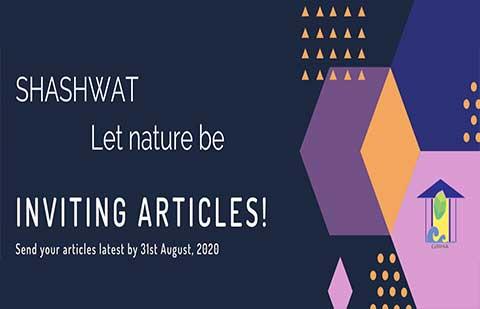Inviting articles for Shashwat - The Annual GRIHA Magazine (2020)

The Annual Magazine of GRIHA Council "Shashwat - Let Nature Be", is released every year. Its previous issues had themes such as, 'High Performance Habitat', 'Transforming Habitats', 'Sustainable is Affordable', 'Fostering Partnerships for Sustainable Habitats' and 'Approach to Integrated Sustainability'. It encompasses articles, interviews and testimonials from experts with diverse backgrounds who have significantly contributed in new areas of research in the domain of Sustainability. We are happy to announce that Shashwat now has ISSN number for its online version. (ISSN - 2581-9291)
This year, GRIHA Council extends an invitation to you for contributing an article in the 7th edition of the magazine, with the theme - 'Rejuvenating Resilient Habitats.'
The article must be submitted through email to info@grihaindia.org marking a copy to gauri.mathur@grihaindia.org with the subject line: Article for Shashwat, latest by 31st of August, 2020.
The guidelines for submitting articles are as follows:
- Prospective authors are encouraged to write an article specifically for this magazine. It is also possible to draw insights from an already published work. The articles can be related to various aspects of environmental sustainability.
- Authors could be professionals working in the field of sustainability, policy makers, academicians etc. We encourage authors to cover new developments in the field, opinions about various facets of sustainability etc. We invite innovative and stimulating articles related to but not restricted to the list given below:
- Building resilient infrastructure for the future
- Disaster preparedness of infrastructure
- Health and sustainability
- Behavioral changes for sustainability
- Sustainability and lifestyle
- Food and sustainability
- Partnerships for a better planet
- Up-cycling waste
- Improving indoor air quality
- Rethinking occupant health and comfort
- Energy and the environment
- People and planet
- Corporate sustainability
- Extended producer responsibility
- Financial sustainability
- Inclusiveness
- Equitable distribution of resources
- Energy efficiency in habitats
- Water efficiency
- Mitigating plastic pollution
- Natural habitat preservation and restoration
- Construction and demolition waste
- Sustainable landscaping
- Propagating sustainability
- Culture and sustainability
- Green procurement
- Future of sustainability
- Design for all
- Sustainable development goals in India
- Sustainable design solutions
- Mitigating UHIE
- Industrial sustainability
- Regenerative habitats
Please note: The list of topics given above are indicative.
We request you to follow these basic Do's and Don'ts:
One author photograph (to be published with the article) and images relevant to the article have to be submitted. The following guidelines must be followed when submitting photographs:
- Only high-resolution images must be submitted.
- Images should be in JPG format (and the file size should be greater than 1 MB)
- Images should not be blurred and should be minimum 300 DPI
- Images should not be embedded in the word doc. They should be submitted in a separate folder in addition to being placed for reference in the word document.
- Images in the content should be either self-clicked photographs or images from Shutterstock website only to avoid copyright issues.
For the author bio-note, the following points should be kept in mind:
- The word count should be 50-60 words in which the current designation details along with area(s) of interest should be mentioned. In case an author has been felicitated/honoured, then that should be mentioned.
- It should also contain contact details (email id) of the author(s) so that the readers may connect with them.
- Example: Dr ABC, a PhD from the PQR School of Architecture and Design has twenty years of experience in developing cost-effective, sustainable ways of designing community housing projects. At his current role as the CEO of XYZ, he has successfully brought 'green designing' to the fore of agricultural practices.
For the article, the following points should be kept in mind:
- The word count of the article should not exceed 1200 - 1500 words.
- The article headings should not read like sentences; they have to be short and crisp.
- The font should be Times New Roman (size 12) and margins should be normal (i.e. 1" all sides).
- The use of references and/or endnotes is strongly encouraged, as they increase the relevance and significance of an article. Include all appropriate source information (e.g., author, publisher, title of book or article, magazine name, date/year of publication, country of publication, etc.) in Chicago style referencing. The author is responsible for obtaining any necessary permissions for quoted or borrowed material.
- The editorial committee formulated by GRIHA Council will choose the articles from those submitted for publication. The criteria for the selection are: relevance to the Shashwat theme, originality of scope, theoretical sophistication, and pictorial representation, amongst others.